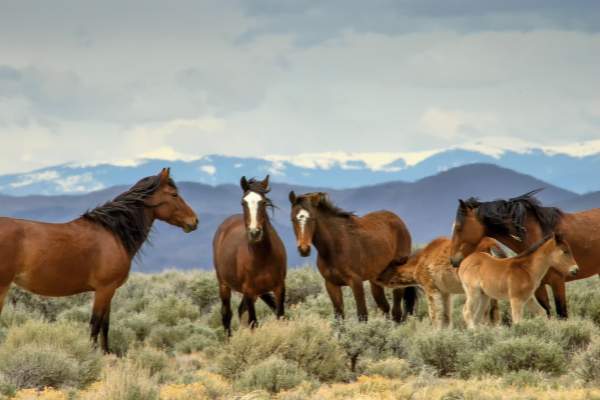FoA urges advocates to demand that BLM tear down fence keeping Onaqui wild horses from forage
The Bureau of Land Management misrepresented information to the Court, resulting in it denying Friends of Animals’ preliminary injunction against the BLM and allowing the agency to move forward with its violent assault on the beloved Onaqui Mountain wild horses.
“Roundups are a terrifying crime against nature. BLM, which is wedded to the meat industry, never considers the physical, social and behavioral impacts of roundups during which wild horses are chased by helicopter, separated from their families, and often injured or killed,” said Priscilla Feral, president of Friends of Animals.
“If a wild horse survives the roundup, experts say the trauma compromises them physically and mentally, putting them on a path of accelerated deterioration.”
FoA points out the biggest lie: There are too many horses on the Onaqui Herd Management Area. Wild horses are not overpopulated. The HMA spans roughly 240,153 acres. The BLM established the appropriate management level within the Onaqui Mountain HMA between 121-210 wild horses. However, in the Onaqui Mountain West allotment, 228 cattle are allowed to graze; and in the Onaqui Mountain East allotment, 299 are allowed to graze.
In the nearby West Lookout Pass allotment, a staggering 8,736 sheep are allowed to graze. The BLM plans to permanently remove 296 wild horses from the Onaqui Mountain HMA and forcibly drug 52 mares with a fertility pesticide, thus obliterating this beloved herd.
“Doomed domestic livestock should not be allowed to dominate federal public lands at the expense of native wildlife,” Feral said. “Since when does the meat industry govern the United States?”
BLM also misled the Court with its claim that if the July roundup did not proceed as planned, it will have to euthanize wild horses “as an act of mercy” because there is insufficient forage production to feed the horses through the summer months.
Meanwhile, nearly 20% of the Onaqui HMA, some 45,000 acres, is still fenced off from wild horses following a 2017 fire despite successful revegetation seeding efforts.
“The BLM can afford a sickening $467,000 roundup but it claims it can’t remove the fence because of lack of funding,” Feral said. “This agency is a national disgrace and needs an overhaul. In the meantime, we urge wild horse advocates who want to help wild horses to adopt a plant-based diet and put the meat industry out of business, and for those living in Utah to demand BLM tear down that fence and offer their assistance!”
Lastly, for decades, BLM’s entire analysis of America’s wild horse population has ignored scientific information about the positive impact of wild horses on the habitat where they evolved. The most recent study indicates wild horses are ecosystem engineers and know how to tap the earth for water. According to a paper published April 29 in the journal Science, the animals use their hooves to dig more than six feet deep to reach groundwater for themselves.
This activity creates oases that serve as a boon to wildlife—American badgers, black bears, and an array of birds, including some declining species such as elf owls. Other studies have demonstrated that wild horses support healthy ecosystems on public land if given enough habitat and left alone. For example, wild horses help spread plant seeds over large areas where they roam.
Wild horses do not decompose the vegetation they ingest as thoroughly as ruminant grazers, such as cattle or sheep, which allows the seeds of many plant species to pass through their digestive tract intact into the soil that the wild horses fertilize by their droppings. Wild horses also help to prevent catastrophic fires and help to build more moisture-retaining soils.
“FoA will continue to go to the wall for wild horses and expose the BLM for the deceitful agency it is,” Feral said.
“We are currently involved in a lawsuit against the BLM’s multiple 10-year wild horse management plans, which conflict with the Wild Horse and Burro Act of 1971, and the Onaqui Mountain HMA is one involved in the lawsuit. The other HMAs include Pine Nut, Muddy Creek, and Eagle Complex. The outcome will determine how BLM can manage wild horses in these HMAs for years to come.”

